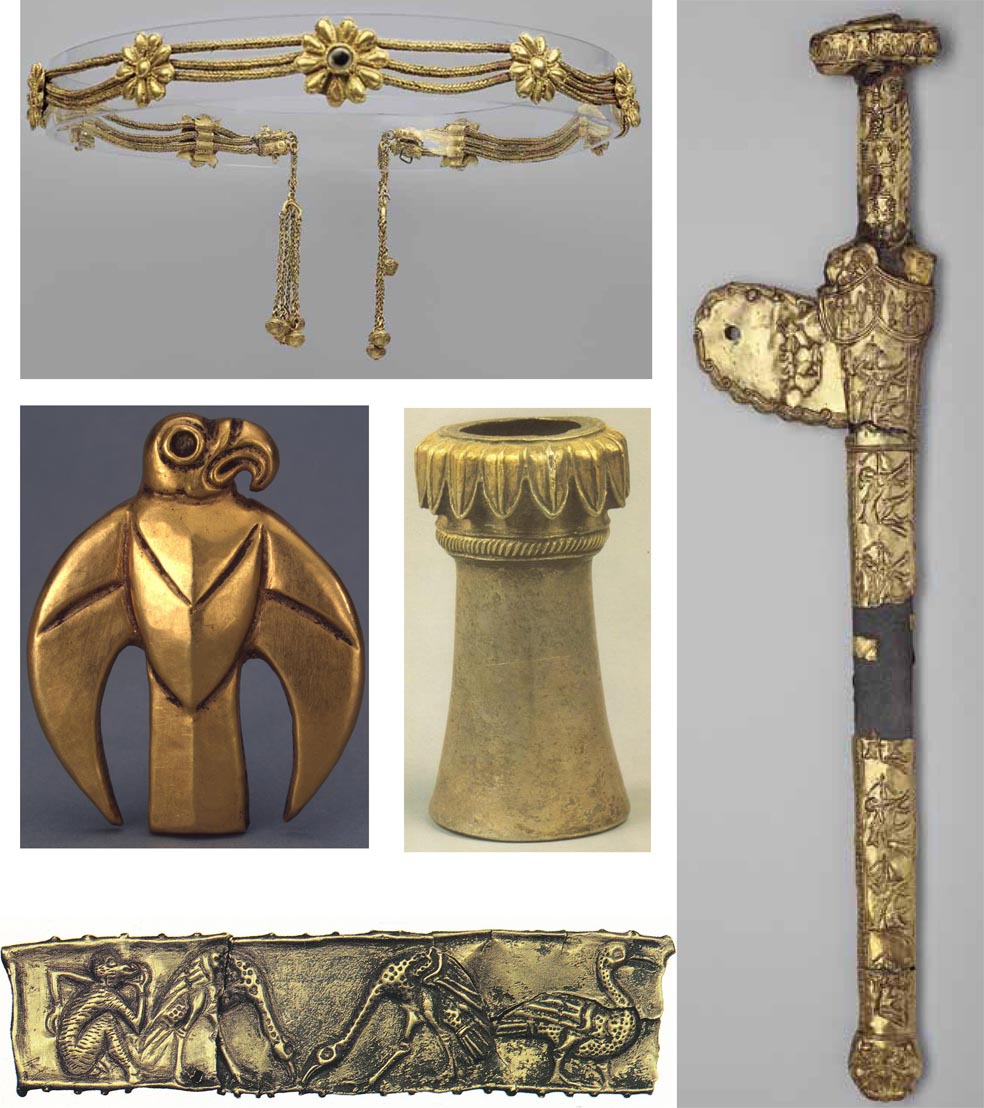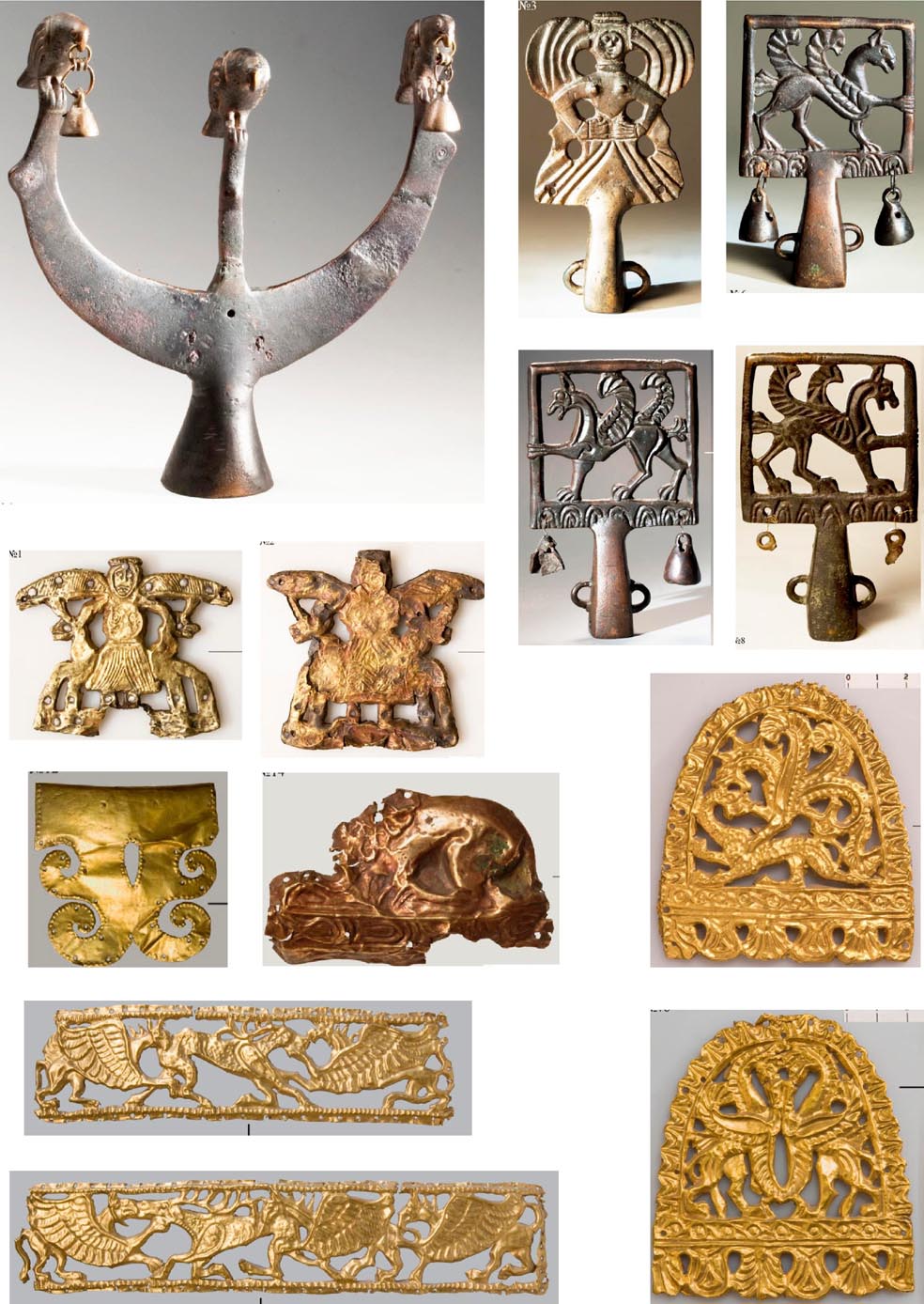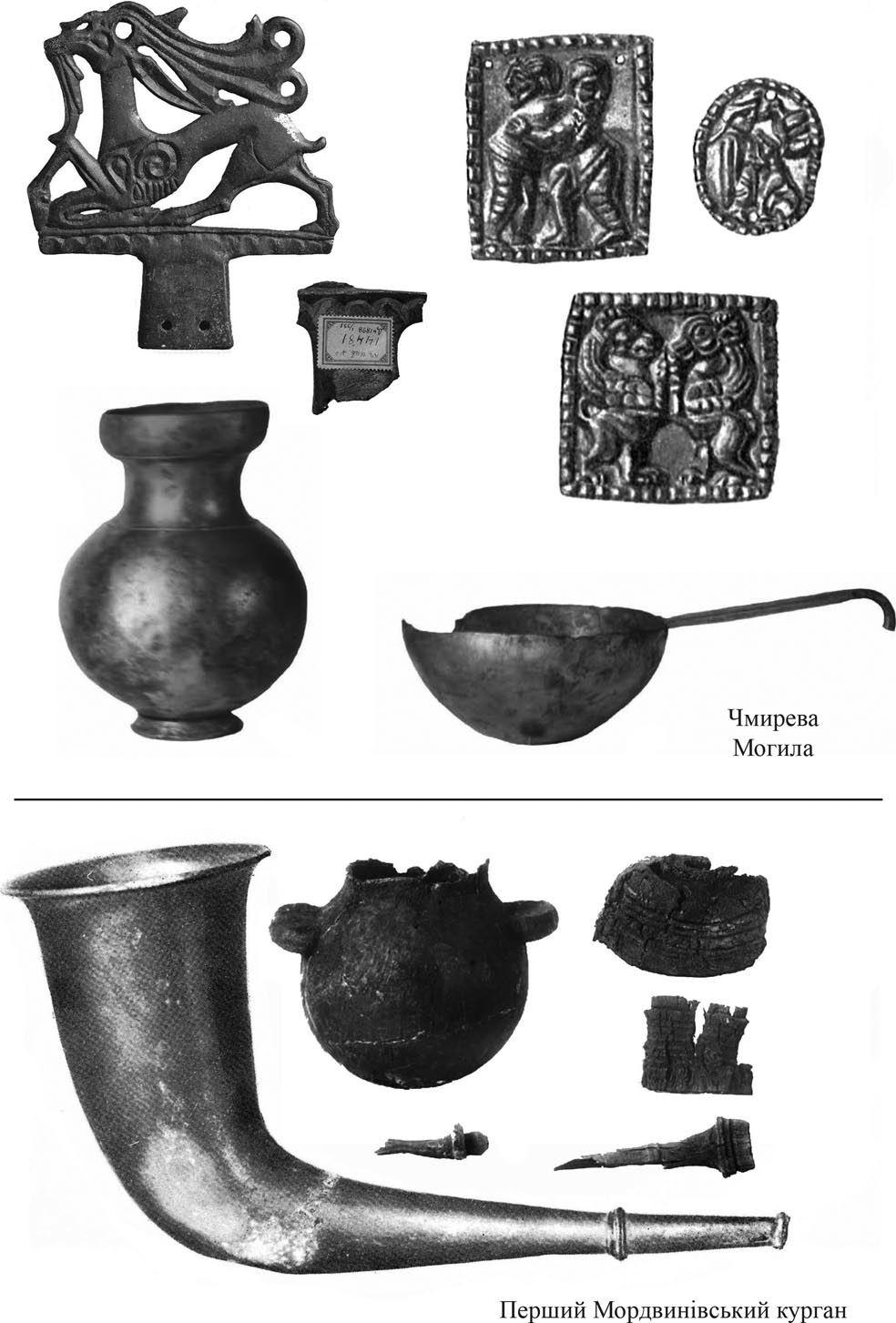Випуск 9. Незавершена реституція
У взаємовідносинах між Україною та Росією відомо не надто багато прикладів результативної реституції. До цього часу наймасштабнішою за об’ємом залишається передача культурних цінностей з музеїв РСФРР до України, що відбулася 1932 року за результатами роботи та рішенням Паритетної комісії. Серед інших колекцій, в Україну з Державного Ермітажу передали деякі матеріали шести скіфських курганів, розкопаних у дореволюційний час, а саме — Литої Могили (Мельгуновський скарб; див. детальніше: http://vgosau.kiev.ua/novyny/proekty/1289-vypusk-3), Олександрополя, Шульгівки, Чмиревої Могили, Іллінецького та Першого Мордвинівського курганів. Але 31 січня 1932 р. українським представникам повністю повернули матеріали лише трьох курганів. Ще з трьох курганів — Олександрополя, Литої та Чмиревої могил — частина предметів, звісно ж найвидовищніших, була “тимчасово” залишена в Ермітажі для виготовлення гальванокопій.
Зокрема, з Литої Могили росіяни залишили знаменитий меч у піхвах із золотою обкладкою, золоту діадему, одну з 17 блях-пташок та пластину із зображенням мавпи та кількох птахів, срібні деталі притронного табурету, цвяхи та бронзові наконечники стріл, усього 17 предметів.
Із Чмиревої Могили для виготовлення гальванокопій відібрали за списком 25 предметів, з розкопок 1898 р. і 1909 р. Це бронзові, срібні та золоті предмети кінської оздоби, золоті пластинки — прикраси одягу, бронзове навершя (розкопки 1898 р.), намисто, прикраси, предмети побуту (розкопки 1909 р.). Крім цього, в Ермітажі за невідомих причин зосталися два предмети — кубок та черпачок, зі срібного «сервізу» Чмиревої Могили, що налічував 10 посудин, хоча до переліку предметів, що тимчасово залишаються для виготовлення гальванокопій, їх не внесли. Нарешті, в Ермітажі залишили і втулку одного із бронзових навершь, переданих до України.
Найрепрезентативнішою, серед затриманих для виготовлення гальванокопій, була колекція з Олександропільського кургану, що налічувала 80 предметів. Це навершя (9 екз.) та вирізні пластини (2 екз.), посуд та окремі його деталі (5 екз.), прикраси та деталі одягу — намисто та пронизки (15 екз.), нашивні пластинки-аплікації (21 екз.), підвіски та фрагменти прикрас (14 екз.), деталі кінської оздоби (15 екз.).
Зберігається в Ермітажі і частина предметів з Першого Мордвинівського кургану, колекцію якого росіяни повинні були передати повністю. Справа в тому, що під час передачі археологічних колекцій у 1926 р. з Державної академії історії матеріальної культури (ДАІМК, колишня імператорська археологічна комісія) до Ермітажу, частину предметів з Першого Мордвинівського кургану помилково атрибутували як знахідки з Кубані, й надали відповідні номери інвентарної групи «Ку». Це непорозуміння виправили вже після 1932 р. і розпізнані предмети перевели до групи «Дн» з порядковими номерами колекції Першого Мордвинівського кургану — Дн 1914 1/44—50. Цю колекцію склали дерев'яна посудина з двома ручками-упорами та фрагменти інших дерев'яних предметів — уламки циліндричної піксиди, виточеного стрижня (веретена?), коробочки та дощечок, а також кістяні пластинки з циркульним орнаментом і дві золоті трубочки-пронизки. Крім цього, встановлене походження з Першого Мордвинівського кургану срібного ритону, переданого в Ермітаж з ДАІМК разом з кубанськими колекціями в 1926 р.
Усі згадані предмети росіяни залишили в колекції Ермітажу і активно залучають до різних напрямків музейної роботи — експонують в постійній експозиції (зокрема — в залах Золотої та Діамантової комор), хизуються знахідками з території України на численних виїзних закордонних виставках, прикрашають привласненими історико-культурними цінностями різноманітні видання художніх альбомів та каталогів. Однак видається, що термін у 90 років є цілком достатнім для виготовлення якісних гальванокопій 122 предметів і ці знахідки, згідно з узгодженими правовими рішеннями, час уже повернути їх законному власнику — Музейному фонду України. Отже, директорові Ермітажу М. Б. Піотровському, очільникові протягом декількох останніх десятиліть, і, як нещодавно виявилося — палкому прихильнику спеціальних культурних операцій, — варто було б замислитися над проведенням однієї із таких операцій з повернення зазначених музейних предметів в Україну.
Леонід Бабенко,
старший науковий співробітник Харківського історичного музею імені М. Ф. Сумцова
Release 9. Incomplete restitution
There have been few examples of successful restitution in the relationship between Ukraine and Russia. Until now, the largest transfer of cultural values from the museums of the RSFSR to Ukraine took place in 1932 following the work and the decision of the Parity Commission. Among other collections, some materials from six Scythian burial mounds excavated in pre-revolutionary times were transmitted to Ukraine by the State Hermitage. Namely, there were artifacts from Lyta Mohyla (Melgunovsky treasure) (more details at the following link: http://vgosau.kiev.ua/novyny/proekty/1289-vypusk-3), Olexandropol, Shulgivka, Chmyreva Mohyla, Illinetsky and First Mordvynivsky burial mounds. However, on January 31, 1932, only the materials of the three kurgans were completely returned to the Ukrainian representatives. Part of the artifacts, of course, the most spectacular ones, from the other three burial mounds — Olexandropol, Lyta and Chmyreva Mohylas — were “temporarily” left in the Hermitage for making their galvanic copies.
In particular, the Russians retained the famous sword in a scabbard with a gold cover, a gold diadem, one of 17 plaques in the shape of birds and a plate with the image of a monkey and several birds, silver fragments of a throne stool, nails and bronze arrowheads — 17 items in total.
25 artifacts from the Chmyreva Mohyla, found during the excavations of 1898 and 1909, were selected according to the list, to create their galvanic copies. These were bronze, silver, and gold items of horse ornaments, gold plates — clothing ornaments, a bronze pole-top (excavations of 1898), a necklace, ornaments, and household items (excavations of 1909). In addition, for unknown reasons, two objects remained in the Hermitage — a cup and a ladle of the silver service found in the Chmyreva Mohyla, which consisted of ten pieces, although they were not included in the list of artifacts temporarily kept to make their galvanic copies. Finally, the socket of one of the bronze pole-tops, transmitted to Ukraine, was also left in the Hermitage.
The collection from the Olexandropol burial mound, which consisted of 80 objects, was the most representative among those kept for the production of galvanic copies. These were pole-tops (9 pieces) and cut-out plates (2 pieces), tableware and its separate parts (5 pieces), jewellery and details of clothing — necklaces and tubular beads (15 pieces), embroidered appliqué plates (21 pieces), pendants and fragments of jewellery (14 pieces), details of horse ornaments (15 pieces).
Part of the items from the First Mordvynivsky burial mound, the entire collection of which was supposed to be returned by the Russians, are also kept in the Hermitage. The fact is that during the transfer of archaeological collections in 1926 from the State Academy of the History of Material Culture (the former Imperial Archaeological Commission) to the Hermitage, part of the artifacts from the First Mordvynivsky burial mound were mistakenly attributed as the finds from the Kuban, and the corresponding numbers of the “Ku” inventory group were assigned to them. This misunderstanding was corrected already after 1932, and the identified objects were transferred to the “Dn” group with the respective serial numbers of the First Mordvynivsky Kurgan collection — Dn 1914 1/44—50. This collection consisted of a wooden vessel with two lug handles as well as fragments of other wooden objects — pieces of a cylindrical pyxide, a turned rod (spindle?), a little box and planches, as well as bone plates with a circular ornament and two gold tubular beads. In addition, it has been identified the provenance of the silver rhyton from the First Mordvynivsky Kurgan, transmitted to the Hermitage from the State Academy of the History of Material Culture together with the Kuban collections in 1926.
The Russians retained all the mentioned items in the Hermitage collection and used them in various areas of museum activities. The artifacts are displayed in permanent exhibitions (in particular, in the halls of the Golden and Diamond Chambers). The finds from the territory of Ukraine are shown off at numerous foreign exhibitions. The appropriated historical and cultural values adorn various publications in art albums and catalogues. However, it seems that the term of 90 years is sufficient for the production of high-quality galvanic copies of 122 artworks. It is time to return these finds to their rightful owner — the Museum Fund of Ukraine in compliance with approved legal decisions. So, the director of the Hermitage, Mikhail Piotrovsky, who has led the Museum for the past several decades and, as it turned out recently, is an ardent supporter of special cultural operations, should think about conducting one of such operations to return the mentioned museum items to Ukraine.
Leonid Babenko,
Senior Researcher in Mykola Sumtsov Kharkiv Historical Museum

Предмети з Литої Могили (Мельгуновський курган), залишені в Державному Ермітажі для виготовлення гальванокопій: діадема (Дн 1763 1/18), бляха-птах (Дн 1763 1/10), наконечник ніжки притронного табурета (Дн 1763 1/23), пластина із зображенням мавпи та кількох птахів (Дн 1763 1/21), меч у піхвах із золотою обкладкою (Дн 1763 1/23)
Artifacts from the Lyta Mohyla (Melgunovsky Burial Mound), retained in the State Hermitage for the production of galvanic copies: diadem (Dn 1763 1/18), plaque in the shape of bird (Dn 1763 1/10), tip of the leg of the throne stool (Dn 1763 1/23), plate with the images of monkey and several birds (Dn 1763 1/21), a sword in a scabbard with a gold cover (Dn 1763 1/23)

Предмети з Олександропольського кургану, залишені в Державному Ермітажі для виготовлення гальванокопій: навершя (Дн 1851 1/1, 2, 15, 17; 1853/3, 5, 6), оббивка дерев’яного посуду (Дн 1853 1/53), бляха у вигляді лева (Дн 1851—1856 1/32), ажурні пластини (Дн 1856 1/16, 17)
Artifacts from the Olexandropol Burial Mound, retained in the State Hermitage for the production of galvanic copies: pole-top (Dn 1851 1/1, 2, 15, 17; 1853/3, 5, 6), plaques of wooden dishes (Dn 1853 1/53), plaque in the shape of lion (Dn 1851—1856 1/32), openwork plates (Dn 1856 1/16, 17)

Предмети залишені в Державному Ермітажі для виготовлення гальванокопій та не передані через помилки обліку: Чмирева Могила: навершя (Дн 1898 1/328), втулка навершя (Дн 1898 1/331), пластинчасті аплікації (Дн 1898 1/290, 291, 293), кубок (Дн1909 1/9) та черпачок (Дн1909 1/10); Перший Мордвинівський курган: дерев’яна посудина (Дн 1914 1/44), уламки дерев’яної піксіди (Дн 1914 1/45) та дерев’яного веретена (Дн 1914 1/46), срібний ритон / ріг (КуП 1926 1/158)
Artifacts retained in the State Hermitage for the production of galvanic copies and not transferred due to registration mistakes: Chmyreva Mohyla: pommel (Dn 1898 1/328), socket of the pole-top (Dn 1898 1/331), plate applications (Dn 1898 1/290, 291, 293), cup (Dn 1909 1/9) and ladle (Dn 1909 1/10); the First Mordvynivsky Burial Mound: wooden vessel (Dn 1914 1/44), fragments of a wooden pyxide (Dn 1914 1/45) and a wooden spindle (Dn 1914 1/46), silver rhyton/horn (KuP 1926 1/ 158)
05.12.2022
Проєкт здійснено за підтримки Стабілізаційного фонду культури й освіти Федерального міністерства закордонних справ Німеччини та Goethe-Institut. goethe.de
The project is funded by the Stabilisation Fund for Culture and Education of the German Federal Foreign Office and the Goethe-Institut. goethe.de








